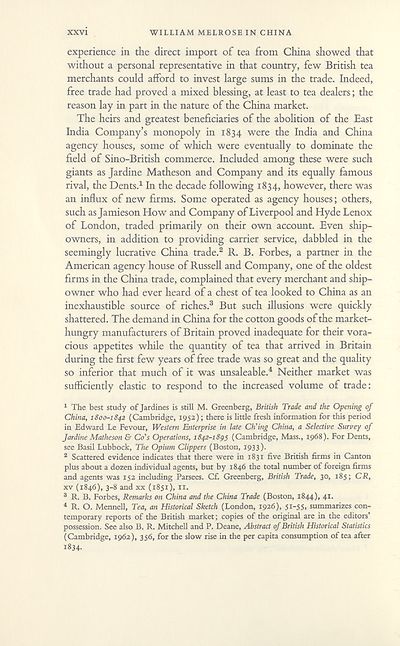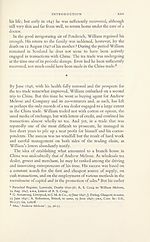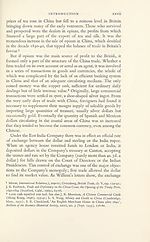Series 4 > William Melrose in China, 1845-1855
(31) Page xxvi
Download files
Complete book:
Individual page:
Thumbnail gallery: Grid view | List view

XXVI
WILLIAM MELROSE IN CHINA
experience in the direct import of tea from China showed that
without a personal representative in that country, few British tea
merchants could afford to invest large sums in the trade. Indeed,
free trade had proved a mixed blessing, at least to tea dealers; the
reason lay in part in the nature of the China market.
The heirs and greatest beneficiaries of the abolition of the East
India Company’s monopoly in 1834 were the India and China
agency houses, some of which were eventually to dominate the
field of Sino-British commerce. Included among these were such
giants as Jardine Matheson and Company and its equally famous
rival, the Dents.1 In the decade following 1834, however, there was
an influx of new firms. Some operated as agency houses; others,
such as Jamieson How and Company of Liverpool and Hyde Lenox
of London, traded primarily on their own account. Even ship¬
owners, in addition to providing carrier service, dabbled in the
seemingly lucrative China trade.2 R. B. Forbes, a partner in the
American agency house of Russell and Company, one of the oldest
firms in the China trade, complained that every merchant and ship¬
owner who had ever heard of a chest of tea looked to China as an
inexhaustible source of riches.3 But such illusions were quickly
shattered. The demand in China for the cotton goods of the market-
hungry manufacturers of Britain proved inadequate for their vora¬
cious appetites while the quantity of tea that arrived in Britain
during the first few years of free trade was so great and the quality
so inferior that much of it was unsaleable.4 Neither market was
sufficiently elastic to respond to the increased volume of trade:
1 The best study of Jardines is still M. Greenberg, British Trade and the Opening of
China, 1800-1842 (Cambridge, 1952); there is little fresh information for this period
in Edward Le Fevour, Western Enterprise in late Ch’ing China, a Selective Survey of
Jardine Matheson & Co's Operations, 1842-189$ (Cambridge, Mass., 1968). For Dents,
see Basil Lubbock, The Opium Clippers (Boston, 1933).
2 Scattered evidence indicates that there were in 1831 five British firms in Canton
plus about a dozen individual agents, but by 1846 the total number of foreign firms
and agents was 152 including Parsees. Cf. Greenberg, British Trade, 30, 185; CR,
xv (1846), 3-8 and xx (1851), II.
3 R. B. Forbes, Remarks on China and the China Trade (Boston, 1844), 41.
4 R. O. Mennell, Tea, an Historical Sketch (London, 1926), 51-55. summarizes con¬
temporary reports of the British market; copies of the original are in the editors’
possession. See also B. R. Mitchell and P. Deane, Abstract of British Historical Statistics
(Cambridge, 1962), 356, for the slow rise in the per capita consumption of tea after
1834.
WILLIAM MELROSE IN CHINA
experience in the direct import of tea from China showed that
without a personal representative in that country, few British tea
merchants could afford to invest large sums in the trade. Indeed,
free trade had proved a mixed blessing, at least to tea dealers; the
reason lay in part in the nature of the China market.
The heirs and greatest beneficiaries of the abolition of the East
India Company’s monopoly in 1834 were the India and China
agency houses, some of which were eventually to dominate the
field of Sino-British commerce. Included among these were such
giants as Jardine Matheson and Company and its equally famous
rival, the Dents.1 In the decade following 1834, however, there was
an influx of new firms. Some operated as agency houses; others,
such as Jamieson How and Company of Liverpool and Hyde Lenox
of London, traded primarily on their own account. Even ship¬
owners, in addition to providing carrier service, dabbled in the
seemingly lucrative China trade.2 R. B. Forbes, a partner in the
American agency house of Russell and Company, one of the oldest
firms in the China trade, complained that every merchant and ship¬
owner who had ever heard of a chest of tea looked to China as an
inexhaustible source of riches.3 But such illusions were quickly
shattered. The demand in China for the cotton goods of the market-
hungry manufacturers of Britain proved inadequate for their vora¬
cious appetites while the quantity of tea that arrived in Britain
during the first few years of free trade was so great and the quality
so inferior that much of it was unsaleable.4 Neither market was
sufficiently elastic to respond to the increased volume of trade:
1 The best study of Jardines is still M. Greenberg, British Trade and the Opening of
China, 1800-1842 (Cambridge, 1952); there is little fresh information for this period
in Edward Le Fevour, Western Enterprise in late Ch’ing China, a Selective Survey of
Jardine Matheson & Co's Operations, 1842-189$ (Cambridge, Mass., 1968). For Dents,
see Basil Lubbock, The Opium Clippers (Boston, 1933).
2 Scattered evidence indicates that there were in 1831 five British firms in Canton
plus about a dozen individual agents, but by 1846 the total number of foreign firms
and agents was 152 including Parsees. Cf. Greenberg, British Trade, 30, 185; CR,
xv (1846), 3-8 and xx (1851), II.
3 R. B. Forbes, Remarks on China and the China Trade (Boston, 1844), 41.
4 R. O. Mennell, Tea, an Historical Sketch (London, 1926), 51-55. summarizes con¬
temporary reports of the British market; copies of the original are in the editors’
possession. See also B. R. Mitchell and P. Deane, Abstract of British Historical Statistics
(Cambridge, 1962), 356, for the slow rise in the per capita consumption of tea after
1834.
Set display mode to:
![]() Universal Viewer |
Universal Viewer | ![]() Mirador |
Large image | Transcription
Mirador |
Large image | Transcription
Images and transcriptions on this page, including medium image downloads, may be used under the Creative Commons Attribution 4.0 International Licence unless otherwise stated. ![]()
| Scottish History Society volumes > Series 4 > William Melrose in China, 1845-1855 > (31) Page xxvi |
|---|
| Permanent URL | https://digital.nls.uk/127694949 |
|---|
| Description | Over 180 volumes, published by the Scottish History Society, containing original sources on Scotland's history and people. With a wide range of subjects, the books collectively cover all periods from the 12th to 20th centuries, and reflect changing trends in Scottish history. Sources are accompanied by scholarly interpretation, references and bibliographies. Volumes are usually published annually, and more digitised volumes will be added as they become available. |
|---|


